Despite the fierce competition from other marketing channels, e-mail marketing remains a crucial marketing tool for businesses large and small that lets them communicate with prospects as well as current customers.
The key to great e-mail marketing is crafting content that people actually want in their inboxes and that speaks to each customer separately, instead of a single e-mail sent to one and all.
The future of e-mail is real-time, behavior-based personalization. A study by Marketo shows that personalized, triggered e-mails based on behavior are 3x better than batch-and-blast e-mails.
With more in-the-moment personalization, marketers will be able to draw greater benefits from their e-mail campaigns, and AI is here to help.
Role of AI in E-mail Marketing
Artificial Intelligence (AI) and machine learning is a computer’s way of using a given set of data to effectively perform a specific function through trial and error. AI can figure out things for itself with its three Ds: Detect, Deliberate and Develop.
Detect: AI can discover which attributes or elements in a set of data are the most predictive and figure out which to pay attention to and which to ignore.
Deliberate: Of the collected data, AI can weigh the most predictive attributes against each other to make a recommendation or answer a question.
Develop: Through machine learning, a subfield of Artificial Intelligence, AI can program and reprogram itself and mature with each iteration. It can alter and evaluate data based on information or results of experimentation.
“Intelligence is the ability to adopt to change.”
– Stephen Hawking
Artificial Intelligence is changing e-mail marketing for the better with 1:1 personalization. AI enables brands to personalize their content and deliver the right message to the right audience at the right time in an automated fashion.
Let us go through the ways in which e-mail marketers can leverage AI to improve their marketing strategy and get better results.
Sending Tailored E-mails to Each User
AI can be used to manage a lot of data. With more people subscribing to your newsletter each day, the data keeps growing and it needs to be managed. AI enables marketers to study customer behavior and manage the data in order to send tailored e-mails to each user.
For example, for someone who is most likely to open e-mails at the start of the day, the message will reach their inbox in the morning. For others, the same e-mail might be overlooked in the morning but have a better chance at being opened in the evening. AI helps you figure out what each customer would like to receive in their inbox and when, based on their past e-mail activity, and lets you send messages tailor-made for and relevant to each person.
A tailor-made e-mail can also be sent by asking the subscribers certain questions and allowing them to set preferences. Then they will only receive relevant e-mails that cater to their interests and needs at the time and day that suits them best.
Take a look at this e-mail from Bespoke Post:
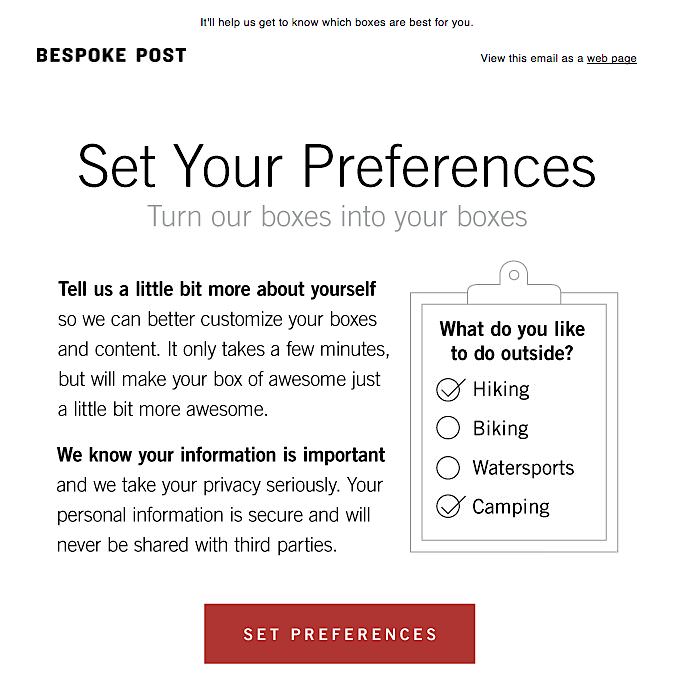
Smart Segmentation and Targeting
Based on the data collected by asking subscribers to set preferences, you need to have a segmented list and send hyper-personalized e-mails to your subscribers. A good e-mail marketer understands that you have different kinds of people on your subscriber list who have different interests and behavior, and it is therefore necessary to categorize them separately and send them different e-mails.
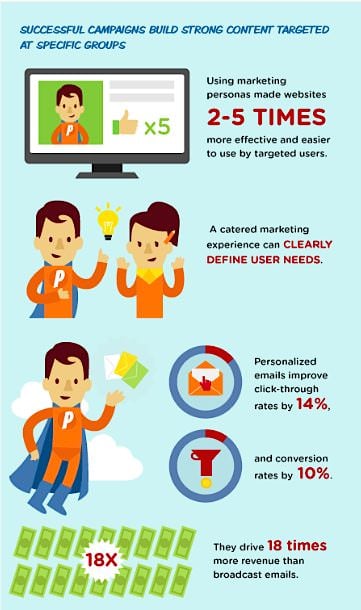
When you divide your subscribers list based on certain criteria, such as demographics, geographies, psychographics and behavior, this is called segmentation.
Segmented e-mail lists help you in getting more opens, CTRs, and conversions while improving customer engagement. AI and machine learning have made it easy to identify the accurate but hidden details of your customers and effectively segment them into clear groups and therefore save you time and resources.
Here’s an example of a personalized e-mail by the time management software RescueTime that studies the behavior of the customer and sends them out as an analysis report. In this example, all e-mails are customized based on the customers’ behavior:
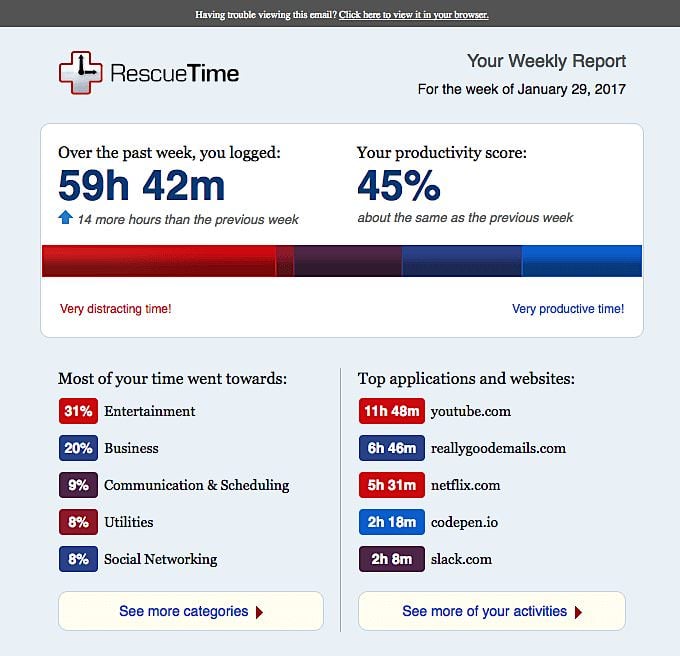
Learn More:
The Complete Guide to Developing and Using Buyer Personas
Attract the Right Prospects With Buyer Personas (Includes Step-by-Step Templates!)
The Right E-mail at the Right Time
With a huge number of e-mails crowding users’ inboxes every day, catching their attention is of prime importance. In marketing, timing is everything, and it if you send one too many e-mails to the right person but at the wrong time, you risk losing them forever.
Marketers need to send the right e-mail to the right person when he or she is most likely to open it. Discovering the optimum time that each customer is most likely to open a message can be extremely time-consuming because it must be determined by examining their past behavior.
AI and predictive analysis have made it easy for marketers to study customer behavior, generate insights, and create an e-mail automation system based on this specific data. Thus, with AI algorithms, you can determine the best time to send relevant e-mails to each and every customer.
When sent at the right time (perhaps a calm Sunday morning), this e-mail from Jack Wills to remind the customer of items in his cart that he hasn’t yet purchased, with a further incentive of free delivery, has a very good chance of success. On the other hand, sent on a hectic Monday morning, it’s not likely to get opened.
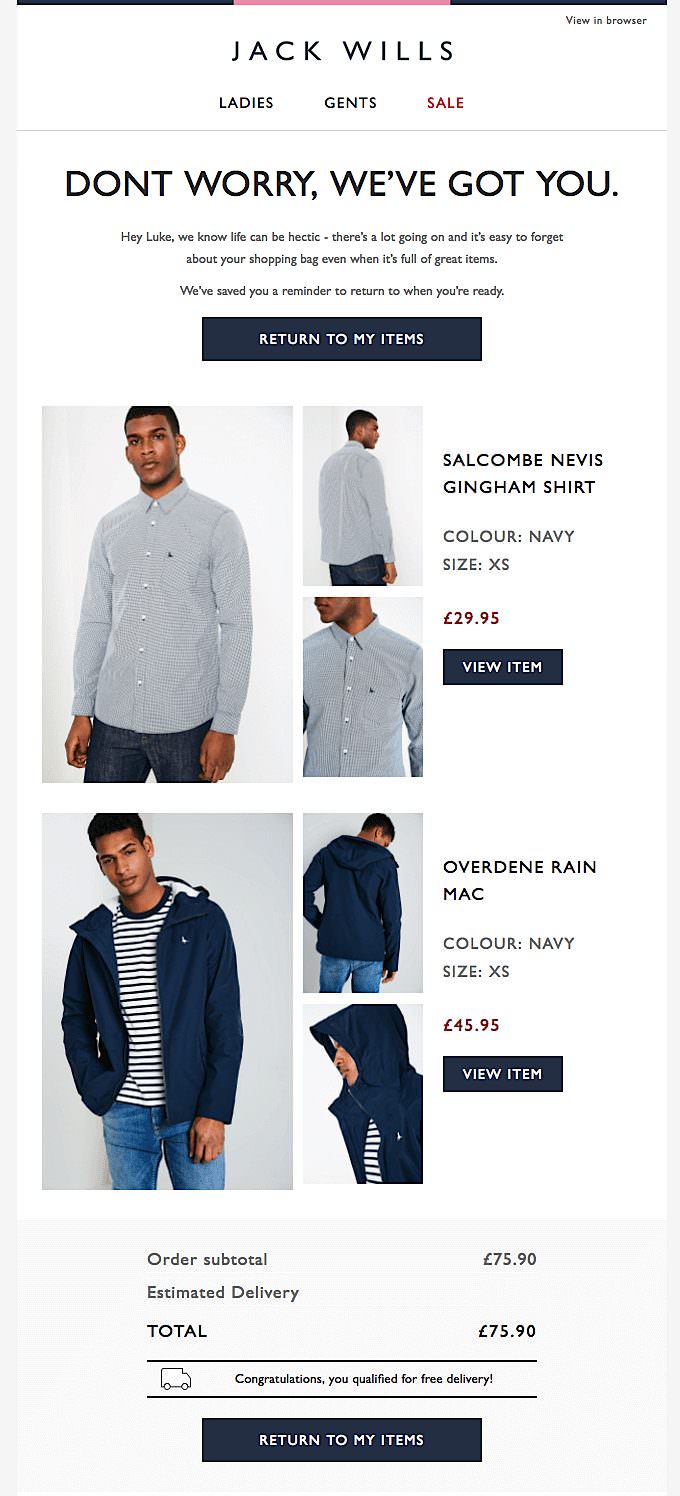
You Might Also Like:
Buyer’s Journey 101: What Your Email Data Says About Your Customers
How to Optimize Your Content Strategy with the Buyer’s Journey
Product Recommendation E-mails
Sending product recommendations to your subscribers based on their browsing or purchase history helps build customer loyalty, thereby improving the click-to-convert ratio of your e-mails. As per a report by McKinsey, 35% of what customers purchase on Amazon and 75% of what customers watch on Netflix are drawn by product recommendations.
This highly personalized marketing strategy can be achieved by using Artificial Intelligence algorithms.
Rather than forcing marketers into the tedious and time-consuming activity of hand-picking products for the customers, AI helps by letting marketers analyze their customers’ online activity, purchase pattern, and browsing behavior. Using AI, you can send tailor-made product recommendations to your subscribers or customers in real-time, boost engagement, and increase click-through rates (and, thereby, sales).
For example, this cart abandonment e-mail from MCM also recommends other products from the brand. All recommended products have a CTA that leads to the corresponding landing page where the subscriber can make a purchase. The AI-honed product recommendation improves the probability of the customer buying the items that were suggested just for them.
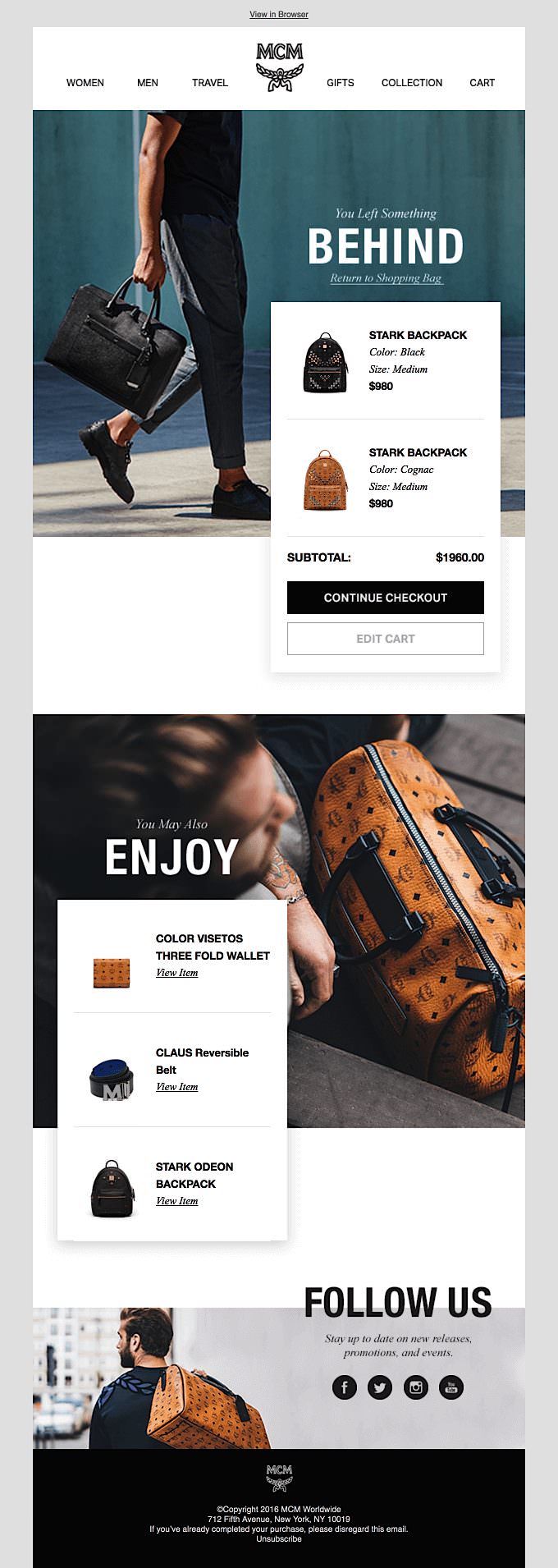
Related Content:
The Future of SEO: How AI and Machine Learning Will Impact Content
3 Ways to Use AI for Instant Brand Building
Customer Lifecycle Marketing
With tough competition in the e-mail marketing industry, marketers need to create effective campaigns that will fetch them maximum ROI from their e-mail campaigns. To create an effective campaign, marketers have to study customer insights and send highly contextual e-mails throughout the customer lifecycle.
Artificial Intelligence and predictive analytics let you generate and analyze insights about your customers by leveraging data based on their behavior and interests. It allows you to discover the average time that a customer takes to make a purchase or the ideal amount of time between purchases.
Understanding this data lets you create powerful e-mail campaigns that inform and engage the customers better.
Take a look at this cart abandonment e-mail from Sunglass Hut which is sent to the customer based on the subscriber’s purchase behavior. When the customer abandons the cart, the data is captured and a cart abandonment e-mail is automatically sent to them within few hours.

Learn More:
How to Get More Responses From Cold Emails
How to Collect and Use Emails Without Breaking Amazon’s Terms of Service
Wrapping Up
Marketers can create personalized e-mail campaigns by using Artificial Intelligence in the following ways:
- Study customer details and find out how often they want to be directly notified about specific events or products of the brand.
- Create segmented customer lists based on demographic, psychographic, and behavioral data to deliver more relevant e-mails.
- Send triggered and personalized welcome and thank you e-mails, as well as messages on special occasions like birthdays, anniversaries, etc.
- Monitor customer behavior and lifecycle and send browse abandonment, cart abandonment, and product recommendation e-mails.
- Send automated triggered e-mails about special events and sales that are personalized beyond just the first name.
AI makes e-mail marketing much simpler by allowing marketers to add value to the e-mails that go beyond just discounts and first-name personalization. This technology lets brands sustain the modern customer by translating the collected data into relevant, unique, and timely content for each individual customer.
If you haven’t incorporated AI into your e-mail marketing strategy yet, now is the right time to begin doing so for better in-the-moment personalization – and, ultimately, sales.



